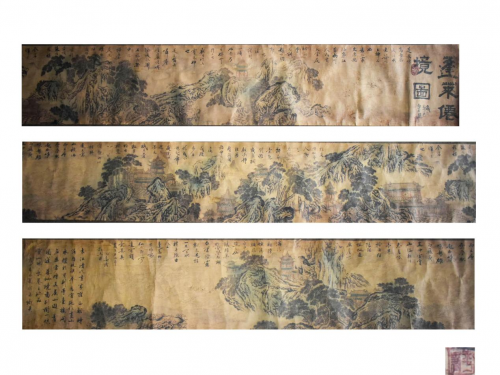
《蓬莱仙境图》,是清代画家袁江创作的绢本设色画,作者以宽阔的胸怀和超越的想象力,描绘出山川湖海吞吐日月的宏伟场面和壮丽景象。蓬莱的传说,八仙渡海口 位于海水浴场东侧海中,西与蓬莱遥遥相望,是根据八仙过海神话传说填海造地新建的景区,空中俯视形似丫腰葫芦。南部外墙设计为游龙起伏脊,龙首位于正门两侧,墙体内侧嵌有甲子神、日游神、夜游神及生肖图案等汉白玉浮雕70余方。景区内建有大型八仙过海汉白玉照壁、流轩、挹清轩、八仙祠、三星殿、财神殿、放鹤亭、环形步廊等民族风格古典式建筑,布置各种雕塑20余尊,奉道教神仙100余尊。袁氏画蓬莱仙境的作品很多,以本幅袁耀所作最为壮观。图中山形脉络皆有动势,突兀怪异;以鬼面皴法画出的山石奇形怪状,层次丰富。华丽严整的宫殿与雄伟而富有动感的山水巧妙地融合,浑然一体,形成画面中动与静、整齐与活泼的鲜明对比,气势博大。作品章法曲折有致,气势翻江倒海,令观者惊心动魄。画面上远近山峦,兀立隐现,在云烟幻灭之中宛如仙境。袁江字文涛,号岫泉。雍正时,召入宫廷为祗侯。袁江是我国绘画史上有影响画家,宫廷画家,转工山水楼阁界画,在清康熙、雍正、乾隆时期,楼阁工整山水当以袁江最有名。当时还有他的侄子袁耀同齐名。他们两人曾受扬州的山西盐商的聘请,到山西作画,作品在北方流传较多。他擅画山水、楼台、师法宋人。山水画主要学宋代闫次平,画石多鬼皴,楼阁主要学郭忠恕,工整严密。他的绘画素材多为古代宫苑,尤长于界画。袁江主要活动于民间。是职业画家,长时间在扬州和江浙一带活动。他擅画山水楼阁,早年师法仇英,中年对古代作品尤其是宋代的山水画作过细心地摹绘。绘画技艺大增。其画传流功力深厚,尤其继承青绿山水传统,所作青绿山水,浑朴有致。中年"得无名氏所临古人画稿,技遂大进"。他将雄伟壮阔的山色与富丽堂皇的楼阁,很好地融为一体,既精细入微,又气势磅礴,有力地提高了"界画"的表现能力,被推为清代"界画"第一。
The Penglai Fairyland Painting is a silk colored painting created by Qing Dynasty painter Yuan Jiang. With a broad mind and transcendent imagination, the author depicts the magnificent scene of mountains, rivers, lakes, and seas swallowing the sun and moon. According to the legend of Penglai, the Eight Immortals Crossing Haikou is located in the sea on the east side of the beach, facing Penglai from afar to the west. It is a newly built scenic area based on the myth of the Eight Immortals crossing the sea, and looks like a waist gourd from above. The southern exterior wall is designed as the undulating ridge of the dragon. The dragon head is located on both sides of the main gate. Inside the wall, there are more than 70 square White Marble reliefs, such as Jiazi God, Dayou God, Night Youshen and Zodiac patterns. There are large White Marble screen wall, Liu Xuan, Yi Qing Xuan, Eight Immortals Temple, Three Star Hall, God of Wealth Hall, Crane Pavilion, circular walkway and other national style classical buildings in the scenic area, with more than 20 sculptures arranged and more than 100 Taoist immortals worshipped. There are many works of Yuan's painting of Penglai Fairyland, among which this painting by Yuan Yao is the most spectacular. The shape and veins in the picture are all moving, abrupt and strange; The mountains and rocks painted using the ghost face texture method have strange shapes and rich layers. The magnificent and orderly palace cleverly blends with the majestic and dynamic mountains and waters, creating a vivid contrast between motion and stillness, neatness and liveliness in the painting, with a grand momentum. The composition of the work is convoluted and elegant, with a magnificent and awe inspiring atmosphere that leaves viewers breathtaking. On the screen, there are mountains far and near, standing and disappearing, like a fairyland amidst the mist and mist. Yuanjiang, with the courtesy name Wentao and the courtesy name Xiuquan. During the reign of Emperor Yongzheng, he was summoned to the palace as a feudal lord. Yuan Jiang was an influential painter in the history of Chinese painting, a court painter, who transferred to the realm of landscape painting and pavilions. During the Kangxi, Yongzheng, and Qianlong periods of the Qing Dynasty, Yuan Jiang was most famous for his neat pavilions and landscapes. At that time, his nephew Yuan Yaotong was also well-known. They were once hired by Shanxi salt merchants in Yangzhou to paint in Shanxi, and their works have been widely circulated in the north. He is skilled in painting landscapes, towers, and imitating Song people. Landscape painting mainly learned from Yan Ciping of the Song Dynasty, with many ghostly and textured stones, and pavilions mainly learned from Guo Zhongshu, with neat and meticulous techniques. His painting materials are mostly from ancient palaces and gardens, particularly skilled in boundary painting. Yuan Jiang mainly engages in folk activities. He is a professional painter who has been active in Yangzhou and the Jiangsu Zhejiang region for a long time. He is skilled in painting mountains, rivers, and pavilions. In his early years, he learned from Qiu Ying, and in his middle age, he meticulously imitated ancient works, especially landscape paintings from the Song Dynasty. The art of painting has greatly increased. His painting skills are profound, especially inheriting the tradition of green mountains and rivers. The green mountains and rivers he creates are simple and elegant. In middle age, he achieved great progress in his skills by obtaining ancient paintings from an unknown family. He integrated the magnificent mountain scenery with the magnificent pavilions very well, which was both delicate and majestic, effectively improving the expressive ability of "boundary painting" and being promoted to the top of "boundary painting" in the Qing Dynasty.





